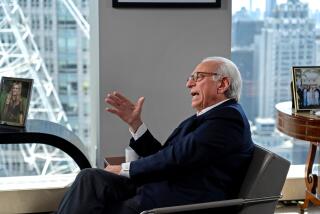So You Didn’t Beat the S&P;? At Least You’re in Good Company
- Share via
Hundreds of financial planners gathered at the annual Morningstar mutual funds conference in Chicago recently, trying to cope with a problem: In the last year, selections for their clients often returned 16%, 17% or even 18%. In spite of that, their clients were disappointed.
Yes, disappointed. No matter that at 17% you’ll double your money in less than five years. No matter that it approaches twice the historical average return on equity investments. Much of the public deemed it inadequate.
The most widely discussed example is Fidelity Magellan, the largest mutual fund in the world and the largest holder of retirement assets. Since Jan. 1, Magellan provided a return of 15.9%, 3.6 percentage points less than the Standard & Poor’s 500 index.
It would be nice if this were a problem only for Fidelity, but while competitors cluck and point fingers, the real news is that under-performance is endemic. During the same period, the average domestic equity fund provided a return of about 13%, 6.5 percentage points less than the S&P; index’s return of 19.5%.
But before you fire or beat up your advisor, let’s take a look at just how difficult it is to select funds that will do well. Let’s see what happened with the choices the experts at Morningstar made in their own 401(k) plan.
Morningstar is a leading tracker of mutual funds, rating most of them, publishing commentary and frequently issuing studies of trends in the industry. Along with Lipper Analytical, it represents the major independent voice about mutual funds.
Just remember: This is not an official portfolio; it is a de facto portfolio that represents the aggregate choices of Morningstar employees. If they made good choices, they beat the market. If they didn’t make good choices, they trailed like everyone else.
In addition, many individuals changed funds during the year, so the composition of their holdings probably changed significantly as well. Here’s the list, ranked in order of employee preference, plus three funds added last spring in an expansion of the plan:
* Brandywine. This popular growth fund had 15.9% of Morningstar’s 401(k) plan money in March 1996. So far this year, the fund returned 9.6%, 9.9 percentage points short of the S&P; 500.
* PBHG Growth. In their second-most popular holding, Morningstar employees suffered a 5.7% loss this year, putting the fund about 25 percentage points below the S&P; 500--and near the bottom of all small-company funds.
* Fidelity Disciplined Equity. After years of superior performance, this fund had a decent year, with a 16.7% return, 2.8 percentage points below the index. But on this fund Morningstar acted last year: “We had [the fund] as a value-added S&P; 500 fund, and that’s what it did most of the time,” Don Phillips said last summer. “But . . . the fund trailed the index by 800 basis points [8 percentage points, in 1995], and we expected greater, well, discipline than that. So we have substituted the Pimco Stocks Plus fund because it seems more likely to deliver the performance of the index with some value added.” It did. Pimco Stocks Plus returned 20.1%, beating the index.
* Vanguard International. This fund can’t be compared to the S&P; 500 since it follows only foreign stocks.
* Lindner Dividend. Another disappointment, with a return of 4.8%; in the bottom 10% of income funds.
Each of the funds listed above accounted for at least 10% of Morningstar’s 401(k) plan assets in March 1996 and together accounted for about two-thirds of all assets in the plan. Here are their less popular choices:
* Fidelity Low-Priced Stock. A nice 12.2% return from a small-company fund, but, like most such funds, still trailed the you-know-what.
* Gabelli Asset. Very close to S&P; at 19%.
* Montgomery Emerging Markets. This fund returned 21.3%, a very good performance. But, like Disciplined Equity, it was kicked out because of earlier stumbles. It was replaced by Templeton Emerging Markets, which did about the same this year.
* Selected American Shares. Among the best performers; fund manager Shelby Davis beat the S&P; index with a return of 20.3%.
* T. Rowe Price New Era. This natural resources-oriented fund returned 10.2%.
* T. Rowe Price New Income. The only pure bond fund on the list and holding only 1.2% of plan assets; it returned 2.1%, a middle-of-the-road return for the category.
* Colonial Newport Tiger. A new addition last year, this Pacific (excluding Japan) fund returned only 4.0%.
* Domini Social Equity. Also added last year, this socially oriented fund returned 21.1%, making it one of three funds in the plan that beat the index.
* Fidelity Real Estate. This specialized fund, the third fund added last year, returned 6.64% this year, although it had a stellar 1996.
Of 14 funds selected by and available to Morningstar employees, only three beat the index. But most were in the top 50% of their categories. Maybe they aren’t doing so badly after all.
Rather than beat up the managers and planners, it may be time to recognize a mania and avoid it rather than join it.
How do you do that? One word: Diversify.
*
Scott Burns writes for the Dallas Morning News. He can be reached at [email protected] or at his Web page at https://www.scottburns.com
More to Read
Inside the business of entertainment
The Wide Shot brings you news, analysis and insights on everything from streaming wars to production — and what it all means for the future.
You may occasionally receive promotional content from the Los Angeles Times.










